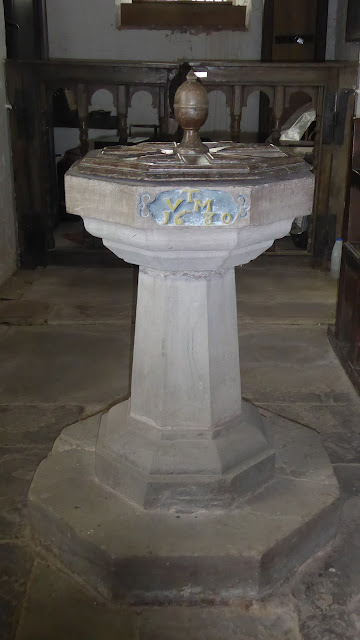On our way back from Hereford Hospital on Thursday, we stopped briefly so I could explore this little church from my lists. It proved very interesting, in many different ways.
This was the approach to the church of St Mary at Monnington-on-Wye, Herefordshire - over 1/4 mile along a pathway. The folk at the Manor of course merely opened a gate in their garden boundary!
High up on the church wall is the armorial crest of I believe Uvedal Tomkyns, who married Mary Capell. Their grave slabs are inside the church. Uvedal derives from the Lancashire surname "Udal".
Outside the church is a stone slab which was apparently the last resting place of Owain Glyndwr - a belief which has existed since at least 1679. However, there was confusion over the Monnington name and it is believed he rests at Monnington Straddel.
The font dates from 1680, and is date marked with the initials T/VM. (Uvedal and Mary Tomkyns ). Only the 15th C tower remains from the earlier church on this site.
Notes about the bells - I hope you can click on the photo and enlarge it.
A plain church, with no electricity, just oil lighting , but goodness, it has a history on all sorts of levels, from the people who lived in the Manor house, to the farmers and farm workers and connections to the Rev. Francis Kilvert as his sister Thersie was married to the Vicar here (William Smith). It was completely refitted in 1679.
The Royal Coat of Arms of Charles II, showing which side the Lord of the Manor was on during the Civil War. Good for him (from a fellow Royalist).
I was incredibly impressed by this written memorial to their local hero, William Williams, one of the "forlorn hope" at Salamanca, whose gravestone inscription had sadly been worn away by the weather. I could see where the Williams plot was outside, and a couple of remaining gravestones, but he is forever remembered inside the church. What tales he must have been able to tell. I do wonder if Kilvert spoke to him (as he did "the old soldier" in Clyro).
The Roll of Honour - for a small hamlet and area, they gave of their best it would seem.A beautifully carved pulpit also dating from 1679.
One of the old Yew trees in the churchyard.
A glimpse of the ancient Manor House (Monnington Court), which includes a Moot Hall completed in 1230 (and rare to find such a thing still intact). Monnington Court was built in two sections, one in the 1400s and the other in the 1600s.
All the land hereabouts is apple orchards belonging to Bulmers.















I had never heard of the term 'moot hall'. Thanks. That plain church is just wonderful. Is it used still?
ReplyDeleteMoot Halls are fairly rare I think - it was generally a Moot Hill or mound, where people met.
DeleteI am pretty sure that the church is still used.
I so enjoyed this post, thank you BB. I’m sure I’ve said before but I love the social history that surrounds old churches. Hoping to return to the Welsh Marches this September. Last year it only took 2 hours 40 mins to drive home from Usk. What a long and illustrious life was enjoyed by William Williams. It is a lovely summer’s day here in the South Downs (blue sky, fluffy clouds, not too hot and a gentle breeze) and I plan to relax and enjoy the garden with some seed sowing, dead heading and harvesting while husband mows our clover-strewn grass. Wishing you a good day too and a successful Fair. Sarah x
ReplyDeleteHi Sarah. We looked at a house in Usk, but it was not structurally sound and Usk felt a little like a dormitory town for Newtown and Cardiff. If you come there this year, let me know and perhaps we could meet up.
DeleteYou had a more relaxing day than me - 13 hours mine lasted - though I will get a brief clip on Bargain Hunt when they asked the price of a piece of Torquay Pottery and Charles talked them out of it as not going to make money at auction :)
A fascinating church with so much history. I read about it recently. All the connections with the past are interesting and I especially like the Kilvert connection :) Thanks so much for sharing and taking some great photos.
ReplyDeleteGlad you enjoyed it and hope that you get to visit it soon RR.
DeleteAt his investiture, the Prince of Wales was forced to admit that he had never heard (or never been told) of Owain Glyndwr. I would have had a stern word with my advisors.
ReplyDeleteWell, total negligence really. He should have be taught Welsh history - or at least the very basics (as it's very interesting, quite apart from he becoming associated with Wales.)
DeleteThat is a lovely old church full of history. I do like the hand written memorial to William William, shows they cared for the guy and the Roll of Honour. The Royal coat of arms the like I have never come across on my visits, really unique that. The font is unusual as well with the date on.
ReplyDeleteI thought the same. The whole community were obviously so proud of him and continued to be up until the present day. Great to be remembered for so long after your death. The Royal Coat of Arms was something special too. The whole church gave so much from so many different angles.
Delete